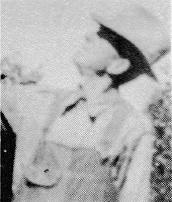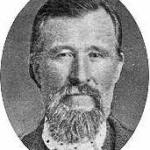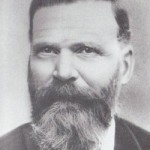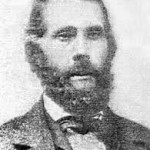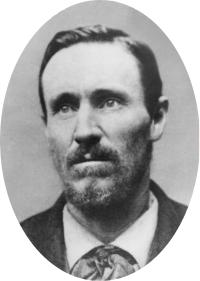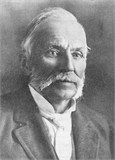Warren Longhurst
(1868 – 1951)
Warren’s parents were William Henry Longhurst, born January 22, 1817, in Little Hampton, Sussex, England, and Ann Preston, who was born April 13, 1825 in Portsmouth, Hampshire, England.
William Henry’s father was a shipbuilder, and the son took up the trade. His business took him to Portsmouth where he met and, in time, married Ann. In associating with their friends, they both heard of the Latter-day Saint Church. She told him about it and was amazed to find that he also was interested. So they went together to hear the Elders. They became convinced that what they heard was true and were baptized. They then tried to convert their families and friends, but were rejected. It took them 15 years to save up the money to emigrate to America. They were poor and it was difficult; also, the whole sum of money had been stolen once and they had to start over. By this time, Ann’s father was wealthy and offered her everything he had if she would give up her religion and stay with him. If not, she was to be disinherited. She chose to cast her lot with the Mormons and bid her family good-bye. They set sail in the early 1860’s. There was much sickness while sailing, but they arrived in New York in good condition, then made the trek across the plains to Salt Lake City. From Salt Lake City they moved to Bountiful, Utah, where his mother died while he was young. His sister raised him.
Warren married Eva Allred on November 17, 1909. Eva’s parents were Byron Harvey Allred, born May 29, 1847 in Kanesville, Pottawattamie, Iowa, and Alta Matilda Rolfe, born August 5, 1855, at Lama, Iowa. They had 12 children of which Eva was the eighth child. She was born in Garden City, Utah.
Warren, the 10th child of his family, was born March 2, 1868. They moved to Woodruff, Utah in 1872 were his mother, and Preston Longhurst, died and was the first reburied in the Woodruff cemetery. He was four years old the time and the youngest in the family so he was raised by his older sister Marintha and her husband George Whittington. His father went to Arizona to live in the United Order with his daughter Clara. He never lived with his father after that except for a few months. George and Marintha moved to Garden City, Rich County on the shores of Bear Lake, where new tracts of land were being open. Here Warren grew up. He was baptized May 14, 1875. His childhood and young man days were very happy ones he enjoyed ice-skating and sleigh riding in the winter and swimming, spearfishing, boating, and berry picking in the summer. He attended high school over the mountain in Randolph where he stayed with his brother, Tom, sometimes hitching a ride part of the way home on the mail sleigh at Christmas time and skating along the edge of the lake the last 11 miles. He also helped on the farm where they raised pigs.
In 1885 his brothers George, Charles, and Joe and his father moved to Idaho along the Snake River and Warren went with them to help drive the cattle. They tried to get him to stay and “grow up” on the homestead but he decided to return to Garden City. He had been keeping company with Myra Irene Allred and they were engaged to be married by April, 1888. Her parents were Alta Matilda Rolf and Byron Harvey Allred, and they were moving to Star Valley, Wyoming to homestead a tract of land and persuaded Warren to go with them. He chose land near the Allreds and built a one-room house on it, made improvements on the land, and in the fall of 1889 he was ready to marry Myra. She had returned to Garden City during the summer to bottle fruit and vegetables for winter use. They were married in the Logan Temple, October 2, 1889 and returned to Afton Wyoming to live on their Homestead. Myra taught school for several years and Warren worked the land, cutting poles for fencing in the wintertime and farming during the summer. There were no children to bless this union, so they were mother and father to all the young people wherever they lived. They were both very good at singing, drama, and teaching in the auxiliaries.
Warren’s father passed away in Idaho, May 17, 1890 in the age of 73. For several years, Warren and Myra worked hard to establish a desirable home. He was chosen to be a member of the High Council when the Star Valley Stake was organized in 1892. He had been ordained a Seventy in 1891.
In the fall of 1898 they were called on a mission to Samoa leaving their dream cottage and farm in the hands of a nephew, James Whittington. The members of the Ward gave them a nice farewell party and to their surprise gave them $75 in cash. They left Star Valley in November, went to Garden City by sleigh, bidding farewell to their relatives in the Cache Valley. They then went to Salt Lake City where they receive their instructions and were set apart as missionaries. They sailed from San Francisco Bay on the steamship Moana, making her maiden voyage across Pacific Ocean, in November 1898. They spent a five day layover at Hawaii visiting members and sizing. However most of the time was spent resting up from there seasickness. Thirteen days later they arrived in the Samoan Islands and were met aboard ship by Mission President E. J. Wood. They saw many strange sites, among which was a war waged very near the mission home. The war was a political nature and soon dwindled away into nothingness, leaving the old chief command. They felt that they were very blessed with learning the language and customs of the people.
Their main assignment was to teach school and the Gospel to the people on the island of Savaii, the largest of the Samoan group. The natives came to help build their first house, which was a far cry from the solid walls of their home in faraway, cold Wyoming. Released from this mission in the fall of 1901. Many poems written by both worn and Myra was told of their wonderful experiences there.
After greeting friends and relatives in Utah and Wyoming, they moved to Mexico in early 1902 were Myra’s parents had gone in the early 1890’s to escape persecution due to their living in polygamy. They lived in Guadalupe, near Colonia Dublan in northern Chihuahua, where many Mormons were already located. Myra’s health was not good and in 1903 she was taken to El Paso, Texas to have her appendix removed, returning soon to her active life.
When President Anthony W. Ivins was released as President of the Juarez Stake in 1907, his home, surrounded by price fruit trees and berries, became the property of the Juarez Stake Academy. Warren and Myra, recently from the Samoan Mission, moved into it. She became its matron and he the Agricultural Director for the Juarez Stake Academy and turned the Ivins block into a small experimental farm. Student agriculturalists learned the fundamentals of horticulture by fulfilling the needs of growing trees in the orchard. They also learned first principles of animal husbandry by studying and working with the cows and horses in the barn and stable. From the flush of Leghorn hens in the coops, fundamentals of poultry were also taught. In garden spots in between the tree rows, all varieties of vegetables were grown and through experimentation it was taught what and how to plan for best results in various localities. A nursery was establish that grew into a career for Warren in later years and for his son, who took up the business when he became unable to carry on. He was among the pioneer fighters of the coddling moth when its infection was discovered. He became an authority on control of pests and of ailments that afflicted cattle, horses and chickens.
While setting up the agricultural department, he was also foremost in promoting cultural activities in the community and helped to forward every good cause. In this he was helped by his wife, Myra, who was capable and willing where and when help was needed. They were a childless couple and in a position to continue being foster parents to the entire student body. They entertained frequently, and were often a part of the programs presented by the school. Both had good voices and entertained many a group dressed in Somoan costumes and singing Somoan songs. In fact they complement each other in public entertainments as well as they did in their home life and patterns for peaceful living.
When Warren later married Eva, Myra’s sister, the children born to Eva had two mothers. These children were: William Preston, Myra Myryl, Harvey Ashton, and Brandon. They lived a very happy life until Myra died September 9, 1912 in El Paso, Texas, shortly after the Exodus.
Warren took his family to Idaho to live for a while, but soon returned to Mexico and there, in November 1918, with all the family ill with the flu, Eva passed away, leaving her husband to care for the children. He started nursery in Dublan where they settled upon returning from Idaho. Here he married Mary Lavinia Moffat, April 12, 1919 and one child, Woodrow Wilson, blessed this union. The marriage was not a happy one and when they separated, Warren was both father and mother to his children. He lived to see them all married and settled. He died peacefully in his home May 14, 1951, and passed on to his reward awaiting the faithful.
The nursery he established has grown until it is one of the largest in the country, having over 750,000 trees all of fruit bearing types, suited to the locale. The nursery is now run by a son Ashton, the only one of his children residing the Mexico.
Nelle Spilsbury Hatch,
Stalwarts South of the Border page 409

